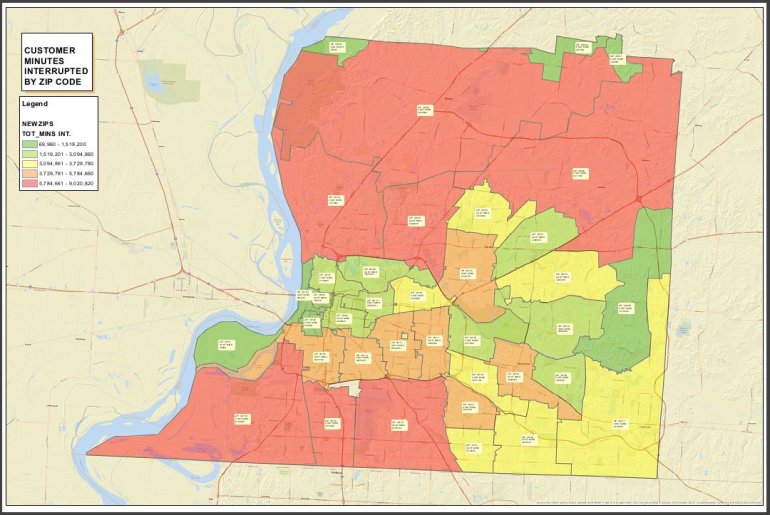MEMPHIS, Tenn. — New data shows just how much longer some Memphis communities are kept in the dark when storms force the lights to go out.
A map released by MLGW on Tuesday shows that areas like Frayser, Raleigh, North Shelby County, Whitehaven and South Memphis experience more minutes of outages than other areas. Green is good, but red, which takes up the large portion of the north and south parts of Memphis, is bad.

The Memphis City Council voted in February not to approve MLGW’s proposed electric rate increases, and some members say the decision not to increase funding is exactly what causes this discrepancy.
Councilman Martavius Jones asked MLGW to present the map at a council committee meeting.
“If you look at 38107, 38128, part of which I serve, 38106, 38119, 38116, those people are nearly interrupted 4 times, 3.8 times, more than the same people I represent downtown,” Jones said. “In essence, somebody who lives downtown, if they’re out an hour that means that somebody else in that red section on average is out 3.8 hours.”
MLGW says there are many reasons why some areas experience more outages than others.
“For example, map areas with heavier populations will accumulate more time off,” said Angelika Taylor with MLGW.
“Also, areas with overhead on rear property lines are more vulnerable to storm and tree related outages and take longer to repair. Some areas have older underground cable which is approaching end-of-life and requires frequent repairs until replaced. In addition, areas with longer circuits and electrical feeds have more exposure to outage caused by vehicles and animals.”
Councilwoman Patrice Robinson, a former MLGW employee, said the rate increases would have allowed MLGW to upgrade some of the infrastructure in the areas with a lengthy power loss time.
“We need to address our infrastructure problems,” Robinson said. “The infrastructure is old. It needs to be replaced.”
Robinson said trees are getting older and falling down, destroying power lines in the process. But with the budget that was passed, MLGW cut down on the amount of tree-cutting it will do. Robinson said that’s a disaster in the making.
“It doesn’t make any sense,” Robinson said. “That’s a lot of people that it impacts. That’s more than half the city that’s being impacted by outages.”
Of all 291,193 MLGW customer meters in the county, about 29 percent of those are in zip codes in red areas, about 23 percent are in orange and about 26 percent are in yellow. That leaves only 22 percent of the county being in the green areas with little power interruption.
She said her fellow council members were pressured to vote against the rate increase by constituents who did not want to see their bills go up, but Robinson thinks these are necessary adjustments to fix the power outage issues.
Residents in the areas that are most affected said they’re used to the outages by now, but they know the infrastructure has to change.
“No, it’s not fair, but what can we do about it?” said Charlene Daniels, a South Memphis resident.
Having lived in the area for nearly 50 years, Daniels keeps a positive attitude but has dealt with her share of outages, and one as recently as last month when she did not have power for a day.
Reasons for the outages can range. The majority are due to downed trees, but many areas in red also have old equipment. Recently, a tree in Uptown took down 12 poles, and crews spent 36 hours making repairs.
Council members Robinson and Jones were two of the six who voted in favor of a rate increase to help upgrade equipment and increase tree trimming. The full council ultimately voted down the rate hike by a vote of 6-7.
MLGW said it will do its best to keep with with this season’s storm damage.
“We’re trying to do our best to balance the needs that our customers have with the funding we have available,” MLGW President and CEO J.T. Young said.
Councilman Jones also said as the city has grown, newer construction has been happening out east, meaning newer MLGW infrastructure there, and there is less money left to make the upgrades to the more historically populated areas.
Wednesday is the first day of spring, which in the Mid-South means a new threat of spring storms.

















